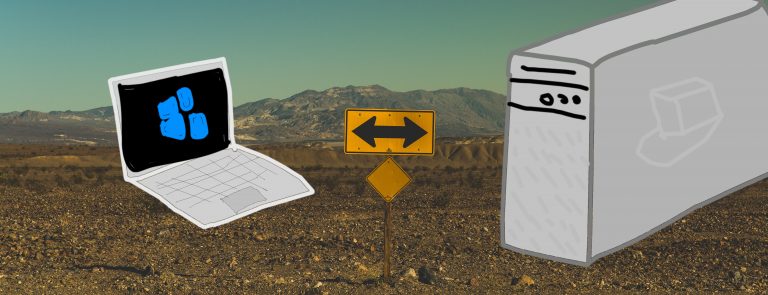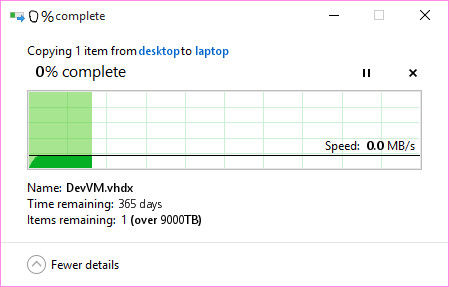insert_linkThat Challenging Question When Buying a New Computer
If you’re anything like me, you would want to guarantee yourself the best return on investment when making a purchase. Accordingly, you may spend a considerable amount of time pondering over the question of a laptop or desktop for programming.
Otherwise, deciding between a laptop or desktop for programming is something you should consider—at the minimum.

It is, indeed, relatively effortless to select computer hardware for the mere mortals. (The gamers, web surfers, document-fixated employees etc, that is to say.)
But, for power users, the situation isn’t invariably easy as evaluating what’s going to give you the best framerates. If you’re here to choose a laptop or desktop for programming, you’re probably concerned with the speed of compilation.
Moreover, this becomes exceedingly deep when the idea of a budget—especially a limited one—is thrown into the mix.
The last point—budget—will have an indisputable, immense impact on the decision between a laptop or desktop for programming. Not to mention, the differences between the characteristics of laptops and desktops for programming only add to the complication.
So, what is the best configuration for you?
Of course, as with many things, this decision ultimately depends on you and your needs.
As a result, the well-justified decision is one in which this is appreciated as well as thoroughly considered.
In this article, I’ll merely guide you through the advantages and disadvantages of laptops and desktops for programmers. We’ll consider the various use-cases a power user—not necessarily a programmer—could experience.
Fresh Computer? Ultimate Checklist for the Best Initial Windows 10 Setup (2018)
insert_linkBenefits of a Laptop for Programming
insert_linkDefined Portability
It would be absolutely wrong, in every respect, to fail to mention portability first; it is perhaps the most defining factor that distinguishes the purpose of a laptop from the desktop.
Keeping within the crispy shell of a peanut, use a laptop as a programmer if you need to go places.
An example of this is if you frequently travel, hence can’t be superglued to a desktop workstation all day: it would be a clear waste of precious time not to be working whilst away from your desk.

In this case, a laptop is the obvious answer to your dreams.
Alas, deciding between a laptop or desktop for programming is not always as simple as that.
For example, you may travel, albeit not frequently. You may not foresee any good opportunities to use a laptop whilst travelling. Perhaps the most moving you do is around the house or workplace.
With that in mind—fully—does a laptop remain relevant?
insert_linkEvaluating Portability for a Not-So Portable Person
This is now where the question of a laptop vs desktop for programming becomes tricky. Indeed, you could go with a laptop if you aren’t a highly frequent traveller.
On the other hand, you may get along with your life faultlessly fine without relying on a laptop. Maybe you could find the space to compromise portability in order to do so.
Here’s another idea: suppose that you find settlement throughout your house or workplace. In other words, there is a multitude of places where you can get work pushed to the finish line.
One might have numerous desks to work at throughout a workplace (depending on the current circumstances), for instance. Likewise, at home, you’re happy working at your isolated basement-desk in addition to the more sociable lounge upstairs.
For this scenario, a laptop for programming would be the better bet; much like investing in butter rather than the fragile Bitcoin.
You see, a laptop can be taken around the house to be used in a diverse spectrum of places. This, therefore, allows you to display ultra-sky-high-quality-videos from your TV using the same device that typically works downstairs.
insert_linkIt’s Got Everything You Need
As a result of its portability, the laptop provides the appropriate facilities to deliver a complete computing experience. In a single device, that is.
Unlike with a desktop, it isn’t strictly essential to buy additional peripherals such as a mouse, keyboard, and monitor. Thus, there is no hidden cost in that respect.
There are fewer cables like there is no complication—since it is all much simpler. You are also saved the hassle of comparing and choosing a keyboard, mice, and the like.
However, that doesn’t mean that you can’t—or shouldn’t—add a monitor, mouse, or keyboard to the mix…
Need a Mouse Too? Best Mouse for Programming 2018? You Need to See This!
insert_linkYou’re Not Locked Out of The Desktop Experience

Investing in portability doesn’t come compromise-free, in spite of its plentiful advantages. To exemplify, you’re probably not always going to be out and about, praising the deities of portability.
Sometimes, you’re going to be at a fixed workplace in which portability is the least of your concerns. Here, even though a laptop for programming increases productivity when being mobile, it can decrease it when stationary.
How paradoxical.
As a consequence, extra measures must be taken to ensure you’re actually using the laptop to your advantage, not a downfall.
This entails creating a desktop-like environment into which you can effortlessly “plug-in” your laptop.
To demonstrate, your keyboard, mouse, and monitor could all be hooked up to a handy dongle. After visiting the neighbours, you solely need to plug in that dongle and the charger. (If the dongle isn’t sufficient for every one of your devices, that is.)
This provides a convenient way of switching between the real-deal of a desktop environment and a portable one.
Unfortunately, though, having the best of both worlds like this comes at an additional price tag. After all, you are paying for two keyboards, two pointing devices, and (at least) two monitors.
While it is evident that a laptop packs along a multiplicity of juicy benefits, the story does not end here. Let us continue our investigation into the question of a laptop or desktop for programming.
insert_linkBenefits of a Desktop for Programming
insert_linkBetter Performance for Your Money
When deciding between a laptop or desktop for programming, money is a mightily principal factor to consider.
In my opinion, desktop computers offer the best value for your money for a multiplicity of strong reasons.
Nevertheless, they may not be such a value-packed deal for someone in desire want of portability. This is simply because, in a desktop, you aren’t paying extra for portability.
Therefore, you don’t get the compromises that come with doing so; the compacted hardware, to be more specific.
All that you are paying for is the machine, so no screen, hinge, keyboard, or mouse (in most cases). It’s just sheer performance, baby, and (almost) nothing else.
insert_linkPotentially Far Cheaper in the Long-Term

Admittedly, you could argue that there’s one main monetary factor when deciding between a laptop or desktop for programming. This is whether or not you are paying for portability.
For you see, the cheaper desktop must be combined with costly peripherals in order to be used properly.
Although there is truth to this, I believe this is not the case when thinking in the long-term.
Peripherals, including monitors and the like, probably exceed the lifespan of your desktop computer. In accordance, they are replaced less frequently.
For this reason, you save you precious coins, replacing only the desktop computer.
Conversely, a laptop requires you to replace the entire unit—keyboard, screen, and the lot! This is evidently more expensive to get away with, though you could still keep the older laptop if still functional.
Furthermore, the story gets even better with self-built computers. The primary takeaway here is that if a certain computer part becomes obsolete or broken, you don’t need to replace everything.
With a laptop or a pre-built system, it is easier to replace the entire system in most scenarios. On the contrary, custom-built PCs only require that you replace one, if not, a few components before setting sail again.
Equally, upgrades are fairly easy, as a lot of components on the market support maximum flexibility. And, being a programmer, this is a useful characteristic as your programming needs flex over time.
In conclusion, if budget is the overwhelming factor, choosing between a laptop or desktop for programming becomes rather easy.
insert_linkThe Option of Monumental Customisation
Whereas you get all the essential components in one laptop, the desktop computer is closer to barebones.
Here is another key, distinguishing factor when choosing between a laptop or desktop for programming: customisation.
Firstly, you have more choice over the display you choose to use, as well as the input devices. This is for the reason that you save money by excluding these devices from the purchase.
Complement the Desktop: MX27AQ Review: Perfect Monitor for Cheap Professionals
Compare this to a laptop, where it is less of a pick-and-mix situation.
Secondly, desktop computers are vastly easier to customise in terms of their individual components. You can even build your own computer from scratch for the utmost value and choice.
Being able to have control to such an extent in this regard will be hugely powerful as a programmer.
Laptops, due to their compact nature, lack the same flexibility you get with desktops. Despite this, there are some system-builders which allow you a greater degree of fine-tuning over a laptop.
However, upgrading the system in the future will assuredly be troublesome. You’ve got to consider the availability of parts for consumers, too—something weak in the laptop department.
insert_linkAccess to a Vast Range of Super-High-End Systems
Another point to mention: were you looking for the highest-end components with that laptop or desktop for programming?
In the event that your pocket is enormously vast, high-end professional computer components may be worthy of consideration. Note that I am talking about professional hardware, beyond the comprehension of those mere, consumer mortals.
Accordingly, you’ve just walked into the realms of server-grade processors, 128GB of RAM, and Quadro graphics cards. Now, be scared—this is programming through the limits.
It is abundantly easier to attain this level of hardware in a desktop computer rather than a laptop. Therefore, between a laptop or desktop for programming, a desktop is the pick for the crazy scientists amongst us.

insert_linkLaptop or Desktop for Programming? Why Not Both?
By now, I hope you have an idea of whether a laptop or desktop is better for your programming needs.
However, I wouldn’t stop there—there is so much more to come! We are yet to consider the feasibility of using a laptop and desktop for programming.
Before I obtained my desktop computer, I predominantly used laptops. In fact, to this day, I have an old (but decent) laptop which I use in conjunction with my more powerful desktop computer.
Consequently, I get all of the benefits described above, without “paying extra”. Why am I not exactly paying extra, despite having 2 computers?
Well, instead of simply replacing my laptop when it started to become too weak, I added to the collection. In other words, I kept the laptop, but then what did I do with it?
Back in May of this year, I published a review of a remarkable monitor I bought, albeit I didn’t keep it. (Also, you can see the full review for why exactly that was.) To clarify, this would be an addition to my current monitor, under the condition that I hadn’t given up.
It is for this reason that now I’ve found that I can almost use my laptop as a secondary screen. In order to do this, I use Input Director to operate both computers with the same keyboard and mouse.
The programme enables me to share the clipboard, so I can copy on one computer, and paste on the other. Right now, as a matter of fact, I am using my laptop to display my productivity system.
Learn More: How to Be Productive with This Powerful Tool—Guaranteed
insert_linkBut How Good is The Portability—Really?
“Okay, there, Big Man Jimmy, that’s splendid for your desktop setup indeed, but what about the portability aspect?”

As always, Dr Mcelduff, I’m thrilled that you’ve asked. Due to the fact that the laptop is connected wirelessly to the network, I only need to unplug the charger.
Then, I can pack the unit up, get my explorer’s hat on, and get the body going places. The foreseeable drawback with this, though, is managing the same stuff between two devices.
To combat the associated problems, I employ multiple strategies to create a seamless experience between the laptop and desktop.
insert_linkMy 4 Tips for Making the Most of a Laptop-Desktop Setup
Firstly, I use cloud-syncing software such that I can access information and files whenever I’m online. For example, I’m using OneDrive to sync files, in addition to cloud-based stuff like Evernote, Todoist, and KanbanFlow.
Secondly, I use TeamViewer to access my powerful machine while away from it. As a result, I can benefit from portability as well as the high performance of a computer countless miles away.
Provided that you are a dedicated programmer, you may want to borrow this strategy. Even with a feeble laptop, you can offload resources and still gain from speedy compilations (when connected to the Internet).
Also, as you may be transferring sensitive data when connected to a remote computer, security is paramount. For this reason, I use a VPN, and you should use a private, secure, and fast VPN, too, like IPVanish or NordVPN.
Thirdly, you could store files on an external hard drive, then take that wherever you go. Perhaps this is more practical if a reliable Internet connection is not always readily available whilst away.
Fourthly and likewise, you could, on the extreme end of things, virtualise your entire programming environment. This, however, requires high-end hardware for the desktop, as well as speedy and spacious storage throughout.
This is because when switching between mobile and stationary, you’ll need to transfer the VM between machines. Thanks to the immensely large file size, this could take a good while.

Perhaps, then, this is not the most practical solution.
insert_linkConclusion: Laptop or Desktop for Programming?
Like I mentioned earlier, I didn’t buy two computers at once—certainly not! Rather, I made thorough use of my laptop for 3 years until acquiring a desktop for programming more intensely.
With that in mind, what do I recommend: a laptop or desktop for programming?
For travelling a lot, get a laptop, but if portability is completely unnecessary, build your own desktop.
Recommended Knowledge: PC Building in 2018—How to Defeat the Infuriating Problems
Otherwise:
Given that you are truly thinking in the future, likely to need portability, and don’t currently have one, buy a laptop. Make sure it is a powerful one you could live with for the years to come, as well.
Remember that, over time, computers will become more and more powerful. So, the later the laptop becomes obsolete, the better.
With that said, when the laptop does become obsolete for your programming needs, buy an overabundantly powerful desktop. Next, use the techniques for a near-seamless laptop-desktop transition above.
If you have any more suggestions regarding using a laptop or desktop for programming, leave a comment. Tell me if you use a laptop or desktop and why whilst you’re down there!
I’ll most definitely be fascinated to hear your thoughts.


